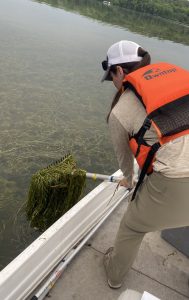Thought Leadership
Stop the Spread: Why it’s Essential to Prevent and Detect Aquatic Invasive Species
August 5, 2025Aquatic invasive species (AIS) are often disruptive. They can also be destructive. These non-native plants, animals, and pathogens infiltrate our lakes, rivers, and wetlands—typically unnoticed—until they’ve done irreversible damage. From clogging water intake systems to decimating native fish populations, AIS pose a serious threat to ecosystems, economies, recreational opportunities, and public health.
The Cost of Inaction
Chinese mystery snail (Cipangopaludina chinensis)
Globally, AIS have cost the economy an estimated $345 billion, with nearly half of that burden falling on North America alone[1]. These costs are largely reactive — focused on damage control rather than prevention. Yet, research and field experience consistently show that proactive investment in prevention and early detection is far more cost-effective and ecologically sound[2].
- Environmental Impacts: AIS can alter the balance of native ecosystems by preying on native species, competing for resources, and introducing diseases. This disruption can lead to a decline in biodiversity and, in severe cases, the collapse of local ecosystems.
- Economic Consequences: AIS can damage fisheries, clog water intake structures and trash racks at dams, and lower property values. The costs associated with managing and eradicating invasive species can run into millions of dollars annually depending on the waterbody and scale of infestation.
- Recreational impediments: AIS can grow to high numbers, making areas of a waterbody impassable by boat or kayak, littering swim beaches with millions of small, sharp shells, and contributing to water quality issues.
- Human Health Risks: Some AIS can pose direct threats to human health by harboring pathogens or producing toxins.
Prevention: The First Line of Defense
As Benjamin Franklin once said, “Prevention is worth a pound of cure”. Preventing the introduction of AIS is the most effective management strategy. This includes:
Stephanie Cole of GEI conducts an aquatic invasive species survey
- Cleaning, draining, and drying boats and gear between waterbodies.
- Avoiding the release of aquarium plants or animals into lakes, rivers, and wetlands.
- Using certified bait and following local regulations when fishing or boating.
- Disposing of unwanted bait
Wisconsin’s “Clean Boats, Clean Waters” program, for example, offers a practical example of how simple actions can make a big difference.
Early Detection: A Critical Second Step
When prevention fails, early detection and rapid response (EDRR) can stop the spread of AIS within a waterbody before a species becomes unmanageable. This involves:
- Routine monitoring of high-risk waterbodies especially near high-risk locations such as boat launches.
- Public reporting of unusual species sightings to agencies and groups managing a waterbody or via platforms like iNaturalist.
- Rapid mobilization of trained personnel and resources to confirm and contain new infestations.
Recent initiatives like Michigan’s AIS BioBlitz[3] and Snapshot Day[4] in Wisconsin empower citizens to be part of the solution.
What Can You Do?
Whether you’re a municipality, utility, lake association, or private landowner, you have a role to play:
- Develop an AIS management plan tailored to your operations. This might include staff training, signage, rapid response procedures, and decontamination protocols for equipment.
- Invest in monitoring, especially in areas with high recreational use or ecological sensitivity.
- Educate your community. Awareness is a powerful tool in preventing unintentional spread.

Stephanie Cole of GEI mapping curly leaf pondweed on Little Green Lake in Wisconsin, 2025.
A Shared Responsibility
Protecting our waters from AIS is not just a regulatory obligation, it’s a shared responsibility. By prioritizing prevention and early detection, we can safeguard biodiversity, preserve recreational opportunities, and reduce costs.
If you’re ready to act, reach out to your local natural resource agency office, environmental consultant, or invasive species partnership. Together, we can keep our waters clean, resilient, and thriving.
Contact me with any questions about AIS monitoring and the value of adding a proactive AIS program to your next project.
[1] www.sciencedirect.com/science/article/pii/S0048969721003041
[2] www.invasivespeciesinfo.gov/subject/early-detection-and-rapid-response
[3] www.micorps.net/events/micorps-aquatic-invasive-species-detection-blitz/?utm_campaign=ais+edr+bioblitz25&utm_medium=pr&utm_source=govdelivery